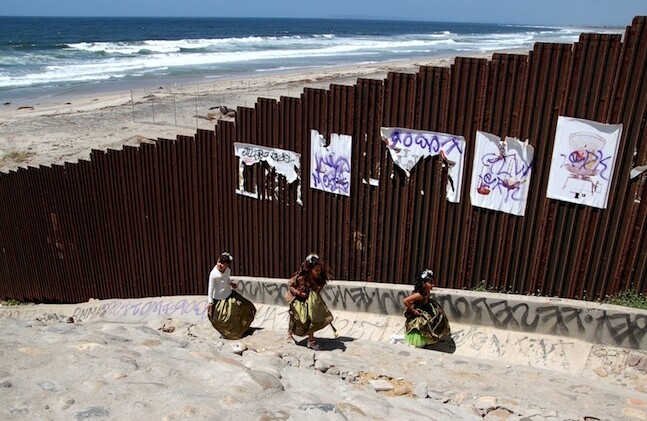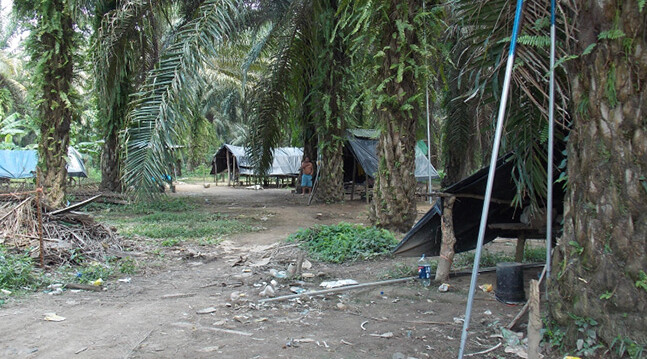Beginning in early 2014, news reports began appearing that noted with increasing alarm the rising number of unauthorized, unaccompanied minors crossing or attempting to cross the U.S. border with Mexico. Soon, news accounts began to describe this influx as a crisis. Yet, by late summer, accounts in the national media virtually disappeared. What made this flow of migrants a crisis? Who are these unaccompanied minors? What caused their migration? Did the United States play a role in it?
The "Crisis"
In fiscal year 2014, the apprehension of unaccompanied alien children increased by 88 percent compared to the previous fiscal year, growing from 35,200 to 66,120. The apprehensions of such unaccompanied minors ranged from a decrease of 7 percent in the Tucson sector and an increase of 4 percent in the Laredo sector to an increase of 152 percent in the Rio Grande sector (from 19,200 to 48,400) from fiscal year to fiscal year.
Previously, the number of unaccompanied minors attempting to enter the United States through its southern border had fluctuated. Between FY2010 and FY2011, apprehensions decreased by 13 percent. But thereafter, apprehensions increased by 50 percent both in FY2012 and FY2013. The increases in apprehensions of unaccompanied minors at the border have been notable. However, they represented less than 10 percent of all unauthorized alien apprehensions until FY2014, when they increased to over 15 percent of the total. Moreover, the increased proportion as well as the total number of apprehended unaccompanied minors in recent years stands in contrast with the total number of apprehensions, which has gone down over the last eight years.That figure reached its peak in FY2000, when more than 1.6 million unauthorized aliens were apprehended. But following the trend of the troubled U.S. economy, the number has declined steadily since FY2006. It has been below half a million apprehensions annually since FY2009.
These figures and proportions offer the first indication of the characterization of the influx of unaccompanied minors as a crisis.While unaccompanied minors may represent a relatively low percentage of all unauthorized alien apprehensions, their detention needs have exceeded the U.S. government's capacity to meet them. Since unaccompanied minors are not detained with unrelated adults, and the number of facilities dedicated to holding unaccompanied children is small, the U.S. government has resorted to temporary accommodations as a stopgap measure. Therefore a relatively small increase in the number of unaccompanied minors reaching the border has swamped the U.S. government's ability to manage the process of assessing the appropriateness of their arrival, disrupting severely their administrative routine.
In addition to insufficient governmental capacity to hold unaccompanied minors in its existing dedicated facilities, the situation has been exacerbated by another development: the dramatic increase in family unit apprehensions. Not covered as extensively in the news media, the number of related minors and adults increased fourfold between FY2013 and FY2014, from 12,900 people to 66,100. With the capacity to hold less than 1,000 adults with children, the U.S. government has had to scramble to devote resources towards meeting this influx of unauthorized migrants.
The news accounts regarding the sudden influx of migrants drew attention to the issue and intensified negative domestic public opinion on the matter. A public opinion poll conducted by the Pew Research Center in July 2014 shows that a clear majority of respondents (53 percent) want to accelerate the evaluative process that determines whether these unauthorized children may remain in the country or should be repatriated, even if some children eligible for asylum are deported. Moreover, as the issue has received increasing media coverage, the narrower matter of unaccompanied children recently entering the United States without authorization has affected the broader immigration debate, with an increasing percentage of respondents to public opinion polls opposing allowing unauthorized immigrant minors to remain in the United States legally. While most poll respondents (two-thirds) still favor allowing the so-termed Dreamers to remain in the country—those children raised in the United States who immigrated there without authorization, often unbeknownst to themselves—this support has dwindled from nearly three-quarters of respondents earlier in the year. Furthermore, the recent influx of child migrants raised the importance and urgency of the issue of immigration generally, with more than a majority of respondents now opining that it is more important to pass significant immigration legislation.
The issue of unaccompanied child migrants has contributed also to undermining the opinion that the public has of President Obama, with less than 30 percent approving of his handling of the situation. As a result of the relatively reduced administrative capacity, shifting public opinion, and partisan political pressure, the administration has diverted attention from its primary focus on apprehension, detention, and removal of "aliens who pose a danger to national security or risk public safety" to its second-ordered priority on "recent illegal entrants." (See U.S. Immigration and Customs Enforcement (ICE) Policy 10072.1, "Civil Immigration Enforcement: Priorities for the Apprehension, Detention, and Removal of Aliens," March 2, 2011.)
Who Are these Unaccompanied Child Migrants?
Historically, the vast majority of unauthorized unaccompanied children arriving in the United States hailed from Mexico. Between FY2009 and FY2013, the number of such unaccompanied minors encountered by immigration authorities ranged from 11,700 children to 17,200. (See U.S. Customs and Border Protection Report) However, beginning in FY2012, the number of unaccompanied minors with whom immigration authorities came into contact began to shift to those arriving from countries in Central America, and specifically from El Salvador, Guatemala, and Honduras. The numbers increased from no more than 1,500 from each of the three countries in FY2011 to more than 15,000 from each country in FY2014, displacing Mexico as the main source of unauthorized unaccompanied minors.
Most of these children—over 80 percent—were adolescents (ages 13 to 17), but increasingly those arriving in the United States from these four Latin American countries are minors under the age of 13. (See Pew Research Center Report) Most notably, this is the case for minors arriving from Honduras and El Salvador, whose share of unaccompanied minors 12 years of age and younger was 27 percent and 22 percent, respectively. Boys represent three-quarters of these unaccompanied minors in FY2014. (See Pew Report) They arrive at nearly twice the rate of girls. But in FY2014 the number of girls entering or attempting to enter the United States nearly doubled from 7,300 in FY2013 to 13,000, particularly teenage girls. Honduras and El Salvador are the countries with the largest proportion of unaccompanied girls trying to cross the border between Mexico and the United States, representing around 40 percent of those unauthorized unaccompanied minors encountered by U.S. immigration authorities.
Unaccompanied minors from Mexico are somewhat distinct from the rest of the minors attempting to enter the country through its southern border.They are overwhelmingly likely to be boys (9 in 10), and also much more likely than Central American minors to have attempted to enter the United States more than once; three-quarters of unauthorized children from Mexico encountered by U.S. immigration authorities had been apprehended more than once. (See Pew Report) This difference is because of a number of factors: Most Mexican minors apprehended at the border and repatriated are likely to be from Mexican states bordering the United States (e.g., Tamaulipas, Sonora), lessening the distance of travel from their point of origin. Furthermore, U.S. law allows for the immediate repatriation of unauthorized children to contiguous countries (i.e., Canada and Mexico), if the child can be safely returned to her or his country of origin.
Why Are Unaccompanied Minors Leaving for the United States?
Economic conditions, and specifically poverty and dearth of employment opportunities, are often assumed to spur the emigration of people from Latin American countries. Certainly the large gap in terms of economic development and employment and business opportunities between the United States and most countries in Latin America is very large. But this has been the case since at least the end of the Second World War; certainly in relation to the countries of Central America.
Honduras, the source country for the largest influx of unaccompanied minors, is among the poorest in the region. The rate of Honduran unaccompanied minors at the U.S. border increased from around 1,000 in fiscal years 2009, 2010 and 2011 to nearly 18,000 in 2014. By comparison, Nicaragua, its southern neighbor, is poorer than Honduras; had a greater unemployment rate (7.2 percent compared to 4.5 percent), and comparable levels of inflation (5 percent) and economic growth (4 percent).Yet, the total number of all removals from the United States that hailed from Nicaragua was less than 1,400 people in FY2013. Neither Haiti, the poorest country in the hemisphere, nor Bolivia or Paraguay, very poor Latin American countries as well, appeared in the list of top ten countries of origin of individuals removed from the United States. (In contrast, Brazil, a middle-income country and fast-developing economy, ranks seventh in the removed individuals category.)
While poor economic conditions may serve as the backdrop that frames the potential desire to emigrate, violence is a more immediate cause, certainly in the case of this influx of unaccompanied minors. Violence or the threat of violence has historically been a prime motivator of emigration, certainly in Latin America.The Mexican and Cuban revolutions, and the insurgencies and counterinsurgencies in Colombia, Peru, Nicaragua, Guatemala, and El Salvador have all produced internally displaced people as well as international refugees, asylum seekers, and exiles in general.
Many of those displaced by violence have fled to the United States, with the status of their reception conditioned by the political relations the United States maintained with their country of origin.When relations were hostile, those displaced by violence have been generally received as refugees (e.g., Cubans, Nicaraguans). When the U.S. government has tried to sustain the foreign government as it faced violent insurgency, the vast majority of those displaced people is not offered governmentally-sanctioned protective status (e.g., Salvadorans, Guatemalans).
The revolutionary movements, insurgencies, and counterinsurgencies in Central America displaced and pushed hundreds of thousands of Central Americans to the United States. Presently there are nearly two million Salvadorans and their descendants in the United States, and an additional 1.2 million Guatemalans and 400,000 people of Nicaraguan origin or descent, many of them tracing their arrival to the 1980s and 1990s, at the height of the political violence in those countries. In contrast, the majority of three-quarters of a million Hondurans who live in the United States arrived since 2000, with 25 percent arriving since 2006. (See Pew Report) Honduras may have been the staging area for the counterinsurgency operations in Nicaragua, but Hondurans themselves never suffered the levels of political violence suffered by their regional neighbors.
The newness of their migration is related to severe natural disasters in the region as well as violence surrounding criminal activities. The Western hemisphere had the world's highest rate of homicide in the world in 2013, with a rate 16.3 people killed per 100,000.1 Central America's homicide rate was the highest in the hemisphere with more than 25 people killed per 100,000. The homicide rate in Honduras was 90 people per 100,000; in El Salvador it was 41, in Guatemala it was 40. In contrast, Nicaragua's homicide rate was 11 people per 100,000; Panama's was 17; and Costa Rica's was eight.
Trans-nationalization of Crime and Criminal Institutions
News accounts from Central America as well as testimony from migrant children indicate that a prime motivator for making their way to the United States is to escape personal violence directed at them in their home country. So far this year 700 minors have been violently killed in Honduras, according to the local news media.
A leading culprit in the Central American public's mind is criminal gangs. These gangs have been active in recruiting children, both through enticements and threats, and killing youth who refuse their overtures. Criminal gangs have existed in Central American countries for many years. However, their activities were contained by the fact that they operated in countries under authoritarian or unconsolidated democratic regimes, which resorted to governmental repression to manage the illegal activities of criminal gangs.2
The tenuous transition from authoritarian regimes to regimes based on procedurally democratic institutions during the 1990s and 2000s coincided not only with the ease in governmental repression, but also with the influx of undocumented aliens repatriated to Central America from the United States. Since the 1990s, and certainly under the present administration, the focus of the U.S. government in dealing with unauthorized immigrants has been to prioritize the deportation of aliens convicted of crimes in the United States. Sixty percent of all removals of unauthorized individuals from the United States in FY2013 involved people convicted of a crime, including more than 80 percent of those removed for residing in the country without administrative authorization.
The repatriation of ex-convicts to countries in Central America (as well as the Caribbean), particularly those with criminal gang affiliations, has contributed to fuel the current social insecurity in those countries, with youth bearing the brunt of the burden. The criminal justice systems in those countries had been alternately or consistently uninterested, unwilling, ineffective, or incapable of addressing the influx of elements that in many instances had become criminalized in the United States. Statistics of any kind are hard to come by and not always reliable, but recent data indicate that there are approximately 73,000 gang members in El Salvador, Guatemala and Honduras,3 with many of them belonging to U.S.-based gangs. Two of these gangs—Mara Salvatrucha 13 (MS13) and the 18th Street gang—were created in Southern California as self-protection organizations by Salvadoran youth during the 1980s, which quickly moved into illegal activities.
The deportation of these U.S. gang-affiliated migrants to Central American countries has created transnational connections among criminal organizations that facilitate the drug, human trafficking, and firearms trades. The transnationalization of these criminal operations has coincided with the penetration of South American and Mexican criminal organizations in Central America as that region, particularly Honduras, has become an important transshipment or transit point for the drug trade.
Local criminal justice systems reacted slowly and ineffectively to the mounting threat from the international criminal organizations, their trade, and the trasnational connections that resulted. When public opinion in those countries clamored for action by their national governments, a typical response was a no-holds-barred repression known locally as mano dura or hardline.These policies often targeted suspected gang members, whether actually involved in criminal activity or not.The sole suspicion of illicit association was enough to detain and prosecute suspects.
Unfortunately, the governments of Honduras, El Salvador, and Guatemala have had a poor record of investigative follow-through. As suspected criminals have been preventively detained, gang members have had opportunities to cement solidarity, communicate, and coordinate activities, as well as harden themselves in prisons. In effect, the hardline anti-crime policies of these governments have proven themselves to be counterproductive; the crime rate initially diminished upon implementation, only to surge again after their initial effects reached their limits.4 Moreover, the governments' own repressive responses have contributed to a climate of social insecurity and impunity.
Final Thoughts
In light of the climate of general violence in which children and youth are living, many are attempting to leave it behind. Existing migration networks, whether based on personal connections and experience or institutionalized in the human smuggling trade, have facilitated this flight of youth.
The United States has tried to stem it. The U.S. government has sought Mexico's assistance in patrolling and controlling its own southern borders with Guatemala and Belize as well as the transit lines that connect the south of the country with its north.It has also provided funding to assist in the repatriation of removed migrant children and other deportees as well as general assistance funding for countries in the region. It has started a public relations campaign in various Central American countries warning of the danger in trying to enter the United States without proper authorization as well as the futility of the enterprise. In all, the U.S. government has deployed short-term measures to arrest the momentum of the surge of children migrants. Yet unfortunately, there does not appear to be an initiative to fund capacity- and institution-building in the criminal justice and law enforcement systems in those countries, possibly the weakest link in the chain of events and long-term propositions.
The United States is facing an immigration dilemma, in part, of its own making. Moreover, the public may simply want to address it as a purely immigration issue, when in fact it is a multifaceted matter. While the public and many government officials may want to see it simply through the prism of migrants arriving in the United States to pursue better economic opportunities, what is ignored in the process is the U.S. population's insatiable appetite for narcotics and other illegal drugs, the clandestine export of firearms and other weapons manufactured in the United States, and the persistent demand for low wage labor and sexual workers. The underlying reasons for the current influx of unaccompanied minors are not changing and will only do so slowly through sustained attention to the issues associated with it. Short-term solutions will remain short-term and are likely to have short-term outcomes.
The current phenomenon is also a wake-up call for the U.S. government as its attention has turned away from its southern border to the Middle East, Central Asia, and North Africa. But perfunctory engagement with other countries to its south does not suffice. To avoid acting from crisis to crisis, the United States and its neighbors must enter into sustained engagement.
NOTES 1United Nations Office on Drugs and Crime. "Global Study on Homicide, 2013: Trends, Contexts, Data." Vienna, Austria. 2Bruneau, Thomas C. 2014. "Pandillas and Security in Central America." Latin American Research Review 49(2): 152-172.
3Bruneau, p. 159.
4 Bruneau.


